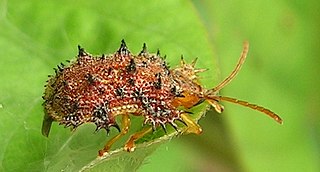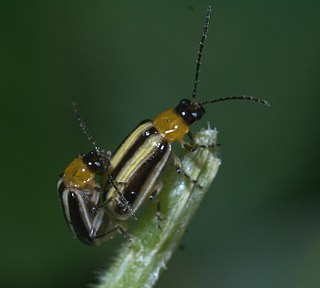
The Eumolpinae are a subfamily of the leaf beetles, or Chrysomelidae. It is one of the largest subfamilies of leaf beetles, including more than 500 genera and 7000 species. They are oval, and convex in form, and measure up to 10 mm in size. Typical coloration for this subfamily of beetles ranges from bright yellow to dark red. Many species are iridescent or brilliantly metallic blue or green in appearance.

The Cassidinae are a subfamily of the leaf beetles, or Chrysomelidae. The antennae arise close to each other and some members have the pronotal and elytral edges extended to the side and covering the legs so as to give them the common name of tortoise beetles. Some members, such as in the tribe Hispini, are notable for the spiny outgrowths to the pronotum and elytra.

The Synetinae are a small subfamily within the leaf beetle family (Chrysomelidae). They are found entirely within the Holarctic, mainly in North America but also appearing in parts of Europe and Asia. The subfamily contains only two genera, Syneta and Thricolema, with a total of 12 described species. The group is sometimes treated as a tribe of Eumolpinae, where they are known as Synetini.
Psyllototus is an extinct genus of flea beetles described from the late Eocene Rovno amber of Ukraine, and from the Baltic amber of Russia and Denmark. It was named by Konstantin Nadein and Evgeny Perkovsky in 2010, and the type species is Psyllototus progenitor. In 2016, a newly described extant flea beetle genus from Bolivia, Chanealtica, was found to be most similar to Psyllototus, based on the characters available for observation.
Xanthonia is a genus of leaf beetles in the subfamily Eumolpinae. It is distributed in North and Central America, and in East, Southeast and South Asia.
Thricolema is a genus of leaf beetles in the subfamily Synetinae. It contains only one species, Thricolema anomala, known from California and Oregon in the United States. Thricolema resembles Syneta, except that the adult females of Thricolema have simple tarsal claws, whereas adults of both sexes of Syneta have bifid claws. The body of an adult is elongated and fibrous. Adults are associated with Calocedrus decurrens.

Syneta is a genus of leaf beetles in the subfamily Synetinae. There are about 11 described species in Syneta. The genus is entirely holarctic in distribution, with species appearing in North America, Siberia, East Asia and Northern Europe.
Colaspoides is a genus of leaf beetles in the subfamily Eumolpinae. It is one of the largest genera in the subfamily, containing over 260 species worldwide. It is an extant genus but there is at least one species, C. eocenicus, found in Baltic amber from the Upper Eocene of Russia, and the genus has also been reported from the Miocene of the Dominican Republic.
Syneta carinata is a species of leaf beetle. It is found in northwestern North America. The specific name was first used by Johann Friedrich von Eschscholtz in his collection before 1831, but was never published by him. Instead, the name is attributed to Carl Gustaf Mannerheim, who published a description of the species in 1843.

Luperini is a tribe of skeletonizing leaf beetles in the family Chrysomelidae. There are more than 30 genera and 500 described species in Luperini.
Syneta extorris is a species of leaf beetle. It is found in eastern North America.

Demotina is a genus of leaf beetles in the subfamily Eumolpinae. There are over 50 described species in Demotina. The genus is native to Asia, Australia and Oceania, though one species is an adventive species in the southeastern United States in North America. Some species are known to be parthenogenetic.

Typophorini is a tribe of leaf beetles in the subfamily Eumolpinae. The tribe contains approximately 100 genera, which are found worldwide. Members of the tribe are mainly characterized by notches on the tibiae of the middle and hind legs, which are sometimes referred to as antenna cleaners. They also generally have a subglabrous body, as well as bifid pretarsal claws.
Syneta pilosa is a species of leaf beetle. It is found in North America.
Shinsaku Kimoto was a Japanese entomologist specialising in the Leaf beetle family (Chrysomelidae).
Tricliona is a genus of leaf beetles in the subfamily Eumolpinae. It contains at least 35 species, and is distributed from India and Southern China to the Philippines and New Guinea.
Basilepta is a genus of leaf beetles in the subfamily Eumolpinae. It is generally distributed in Asia. A single species is also known from central Africa.
Nodina is a genus of leaf beetles in the subfamily Eumolpinae. It is distributed in Asia.

Bromiini is a tribe of leaf beetles in the subfamily Eumolpinae. The tribe contains approximately 120 genera, which are found worldwide. They are generally thought to be an artificial group, often with a subcylindrical prothorax without lateral ridges and covered with setae or scales.

Hermaeophaga is a genus of beetles belonging to the family Chrysomelidae. There are some 60 described species, from the Palaearctic, Oriental, and Afrotropical regions.







